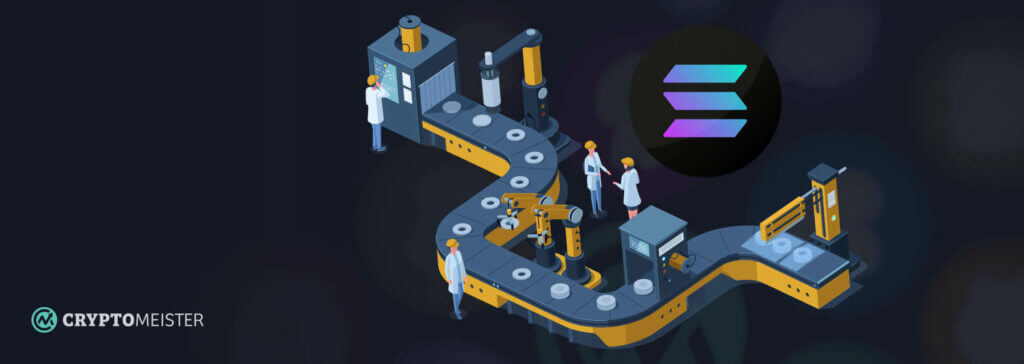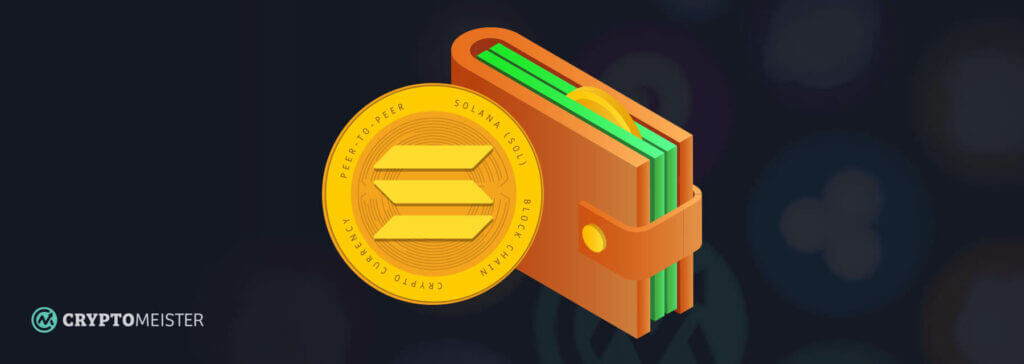
Binance
Only for verified users
Solana is a cryptocurrency built to compete with networks like Ethereum, which support functionalities beyond simple payments.
With Solana you can build DeFi projects, trade NFTs, and enjoy faster transaction speeds and cheap fees. By the end of this article you will understand exactly how Solana works, how to buy Solana, and where to buy SOL coins.

Only for verified users



Solana is a public, open-source blockchain that supports smart contracts, including non-fungible tokens (NFTs) and various decentralized applications.
Solana was created in 2017 by Anatoly Yakovenko and Raj Gokal. Since launching in 2017, Solana has grown to become one of the largest cryptocurrency ecosystems in the world.
The cryptocurrency native to Solana’s blockchain is also called Solana, with the ticker symbol SOL. SOL’s market cap has gradually declined from its November 2021 peak of $78 billion to $11 billion at the time of writing.
The founders of SOL wanted to build a completely new blockchain that could scale. Compared to Visa and Mastercard, which can handle about 65,000 transactions per second (TPS), blockchain transaction speeds at the time of Solana’s creation were only about 15 TPS. Today Solana can theoretically match Visa and Mastercards’ 65,000 TPS at its peak.
The Solana blockchain allows for the creation of smart contracts, allowing developers to create decentralized applications (dApps). Its rapid expansion has made it a serious competitor to other significant programmable blockchains like Ethereum and Cardano – the DeFi dApps on Solana currently have over $2.3 billion locked in them.
Solana Pay, a free-to-use payments framework, has been one of the most exciting breakthroughs with Solana, enabling businesses to take payments directly from customers using Solana-based tokens. Solana also supports the minting and trading of NFTs, with its popularity in this sector recognized by its implementation into Opensea, the biggest NFT marketplace in the world, in 2022.

The Solana blockchain employs two consensus mechanisms to process and confirm transactions – proof-of-stake (PoS) and proof-of-history (PoH).
With PoS, individuals called ‘validators’ validate transactions in a block based on the number of coins they stake using a regular computer.
This is a much less energy-intensive method of confirming transactions than proof-of-work and typically enables higher throughput and lower costs, but it is not as secure as the proof-of-work method used in Bitcoin.
PoH solves the problem of blockchains waiting for an event to be confirmed across multiple validators before processing it by having validators maintain their own clocks by encoding the passage of time themselves. This allows an event, such as a transaction, to be verified much quicker than on other PoS networks.
Solana currently has over 1,000 validators, which makes it theoretically very decentralized, while its maximum theoretical throughput on a gigabit network is 710,000 TPS, rising to 28.4 million TPS on a 40-gigabit network.

Both centralized and decentralized exchanges allow you to buy Solana, but you must be careful when choosing where to buy SOL.
Centralized exchanges are controlled by the entity that created the exchange, and they abide by government laws and regulations, which require them to demand a government-issued identity card from users and restrict any accounts on request.
Decentralized exchanges might seem like the ideal place to buy SOL, seeing as they don’t have the same restrictions, but they come with their own drawbacks, such as liquidity and speed of transaction.
They may also not be available in your jurisdiction, so it’s essential that you carry out your own research before using one.
You can buy Solana from many centralized exchanges, including:
Some decentralized that allow you to buy SOL tokens include:
Follow these steps to buy SOL on centralized exchanges:
If you choose to buy SOL on a centralized exchange, it is best practice to withdraw your SOL to a non-custodial wallet which gives you full control over your private key.
If you want to buy SOL on decentralized exchanges, follow these steps:
These are the most common and convenient ways of paying for your Solana tokens:
Credit card/debit card
Many exchanges allow you to buy Solana with a credit card or debit card, providing your bank supports crypto purchases. Exchanges offer a seamless process for connecting your card to your exchange account. Once it is connected, you can buy Solana at any time and from anywhere.
Bank transfer
Bank transfers are a good workaround if your bank does not support crypto purchases with a credit/debit card. You can buy Solana with this process by transferring funds from your account with the exchange.
You should first make a test purchase of no more than $10 to ensure the process works as expected. Once the purchase is approved and your account is connected, you can begin to buy SOL in larger quantities or withdraw fiat back to your account.
Cryptocurrency
You can also buy SOL tokens with your existing cryptocurrency holdings. Check what SOL pairs are supported on your exchange of choice (e.g. SOL/USDT), swap some crypto into the other coin in the pair, and buy SOL with it.
There are several features within the Solana ecosystem that might convince someone to buy Solana tokens.
Anonymity and censorship-resistance
People buy Solana because it allows them to transact privately. They also choose to buy SOL because it frees them from the possibility of restrictions being placed on their accounts by a centralized authority, such as a financial institution or government regulator.
Fast transactions
Solana’s blockchain design makes it a very attractive option for those looking for fast transactions, which is one of the reasons why it has seen such bug adoption across the DeFi and NFT space.
However, this advantage won’t last long, as the Ethereum protocol will be soon be upgraded (expected to launch fully from 2023) to handle up to 100,000 TPS. Until then, however, Solana has a clear advantage.
Cheap and clean transactions
The cheap cost of transactions is a good reason to buy Solana. It is vastly cheaper than its counterparts, coming in at an average cost per transaction of just $0.00025.
On the other hand, Ethereum’s gas fees fluctuate wildly. If the transactions are more complex or the network becomes congested, gas fees can go into thousands or even tens of thousands of dollars per transaction.
Cleaner transactions also motivate people to buy SOL. Solana’s PoS and PoH algorithms are 99.9% more energy-efficient than PoW networks like Bitcoin and Litecoin, making Solana better for the environment.
Shopping
Solana Pay enables users to make real-time payments in SOL, or with any other supported Solana token, without the assistance of a third party such as a bank or payment processor.
Solana Pay is ideal for businesses since it provides thorough reports on every transaction, including the wallet destination, currency kind, amount, and text fields for the business to characterize the transaction.
This information is kept completely secret from the rest of the network, allowing both the consumer and the merchant to conduct business anonymously.
Gaming
People buy Solana because it facilitates faster transactions for online gambling. Various platforms support Solana betting on sports and casino games like slots, video poker, live dealer, baccarat, roulette, craps, and blackjack.
Various platforms also support Solana staking, yielding up to 4% APY. Many investors buy Solana to stake it and generate passive income.

The purpose of a crypto wallet is to provide safe storage for a collection of keys that grant the holder access to an account on the blockchain. A crypto wallet is used to send, receive, invest, and monitor ownership of cryptocurrencies.
Wallets come in different forms. They can be software wallets that operate on your computer or mobile device or specialized devices called “hardware wallets”, which store your keys in an offline device.
The wallet’s receiving address, also known as the public key (sometimes abbreviated to pubkey), is comparable to a bank account number in conventional finance.
On the other hand, the private key acts as a password to access the wallet and conduct transactions with the tokens stored there.
You can disclose your public key to anyone you transact with, but you must keep your private key a secret to prevent hackers from stealing your coins.
Solana supports a variety of wallet types so that you can find the ideal mix of ease and security.
Some Solana wallets also enable staking, which means putting a certain amount of coins up as collateral to a validator, allowing you to receive SOL tokens as a reward for helping confirm transactions.
The more of a stake a validator holds, the more frequently it will be selected to validate transactions and the more rewards you will receive if you assign your tokens to the validator.
Some exchanges and wallets allow you to stake SOL, including:
The following are some exchanges that also allow you to stake SOL:
Ensure that you have thoroughly researched any wallets you are interested in using so you know what advantages and limitations they have before sending your coins over.
A Solana transaction starts with the PoS algorithm designating a ‘Leader’ – a node that will take charge of the transaction through to completion.
The Leader arranges all the transactions assigned to it in a way that best utilizes the capacity afforded by the nodes. It then validates and broadcasts the transactions to replication nodes known as Verifiers.
These verifiers ensure that the Leader’s validation is accurate, after which the transaction is pushed to the blockchain and made permanent.
Solana draws consumers from all around the world because of its low pricing and higher throughput capacity. Currently, Solana has 1,469 nodes in its ecosystem, with more than 74% of its circulating token supply staked to the network and producing rewards.
There are some risks associated with Solana that you should be aware of before you use it or treat it as an investment:
Excessive centralization
According to data from Messari, more than 50% of Solana’s initial token allocation went to insiders, including prominent venture capital firms like a16z, CoinShares, Alameda Research, Coinfund, and Parafi Capital. Only a fraction of the amount went to the general public, which means the bulk of the tokens are controlled by institutional investors rather than the broader Solana community.
No set maximum supply
In November 2021 it was alleged that Solana had produced millions of additional tokens, which would dilute the supply and reduce the value of each coin.
Anatoly Yakovenko, the founder of Solana, explained these coins were given to a market maker so that the aftermarket would have liquidity. However, some stakeholders are still concerned with the lack of transparency and its possible effects on their holdings.
Concerns over staking architecture
Solana’s staking system has led to concerns that nodes are increasingly staking their coins with a few validators to maximize profits. Solana’s staking architecture is structured in such a way that stakers who split their coins between validators will end up paying double the fees while receiving the same reward.
Outages
Solana has experienced several bouts of high profile network difficulties, some of which resulted in a complete network shutdown for hours on end. This has led to accusations that the blockchain is simply not ready for such large-scale usage.
The legality of Solana is a complex issue because different nations have taken varied stances on cryptocurrencies in general. The US Library of Congress reports that 42 jurisdictions have an implied restriction on utilizing cryptocurrencies, compared to nine countries with an explicit ban.
This means that 144 nations have yet to declare their stance on cryptocurrency, which includes Solana. However, the following nations consider cryptocurrencies to be a financial asset class:
This means that Solana is certainly legal to trade and hold in these jurisdictions. Solana is subject to the basic laws of cryptocurrencies because it has never been singled out as a currency of concern to any country.
Solana is already promising to disrupt payments through Solana Pay, but the network is not stopping there. It is now taking steps to make its entire crypto ecosystem mobile-friendly, thanks to the June 2022 announcement of the Solana Saga smartphone.
Saga is a Solana Mobile Stack that will provide users with a built-in crypto wallet that will also hold NFTs, a dApp store, NFT trading and minting, and more. Blockchain phones are yet to really take off, but with more than just a wallet under the hood, the Solana Saga phone could be the breakthrough that the space needs to go mainstream.
Solana hasn’t produced an updated roadmap in 2022, so it’s unclear what other developments may be in the pipeline.
Although Solana has seen a drop in market capitalization due to the cryptocurrency bear market, it has proved its resilience by retaining its spot among the top 10 cryptocurrencies globally.
Solana is currently ranked as the 9th biggest crypto asset in market capitalization, and has a huge following. The Solana Foundation continues to make investments to grow the ecosystem, such as the Solana Riptide Global Hackathon, which distributed aboutn $5 million in prizes and seed funding to participants.
Solana has already hit all the milestones in its roadmap, with the exception of the full Mainnet launch. The Mainnet was launched in 2020 in Beta, and since then, the Solana ecosystem has attracted thousands of developers.
However, the rise in activity on the network has also had a detrimental effect. The Solana network continues to battle with congestion and outages. The most recent outage occurred on June 1, 2022, and lasted for four hours and ten minutes.
Developers have already released an update to put an end to outages on the network, but only time can tell how effective the updates will be in tackling Solana’s challenges.
Solana is a promising project with lots of adoption, particularly in the field of NFTs, but the SOL token took a huge hit when the FTX exchange collapsed in November 2022.
This is because FTX was a major investor in Solana, and its collapse may have an impact on the future of the project, which also suffered huge reputational damage.Solana has a fast and versatile blockchain, but it is known to be unreliable.
In 2022 it broke down four times and had to be restarted, the eighth time in total since its launch in March 2020. These issues were put down to it still being in beta mode, and its problems have not affected adoption, which has been very impressive.Solana has a faster blockchain than Ethereum, being able to theoretically process over 3,000 transactions per second compared to Ethereum’s 15.
Fees are also better on Solana than Ethereum, being a static $0.00025 per transaction, compared to Ethereum’s volatile fees which have been as high as $70. However, Ethereum is a more reliable blockchain, having never suffered downtime.